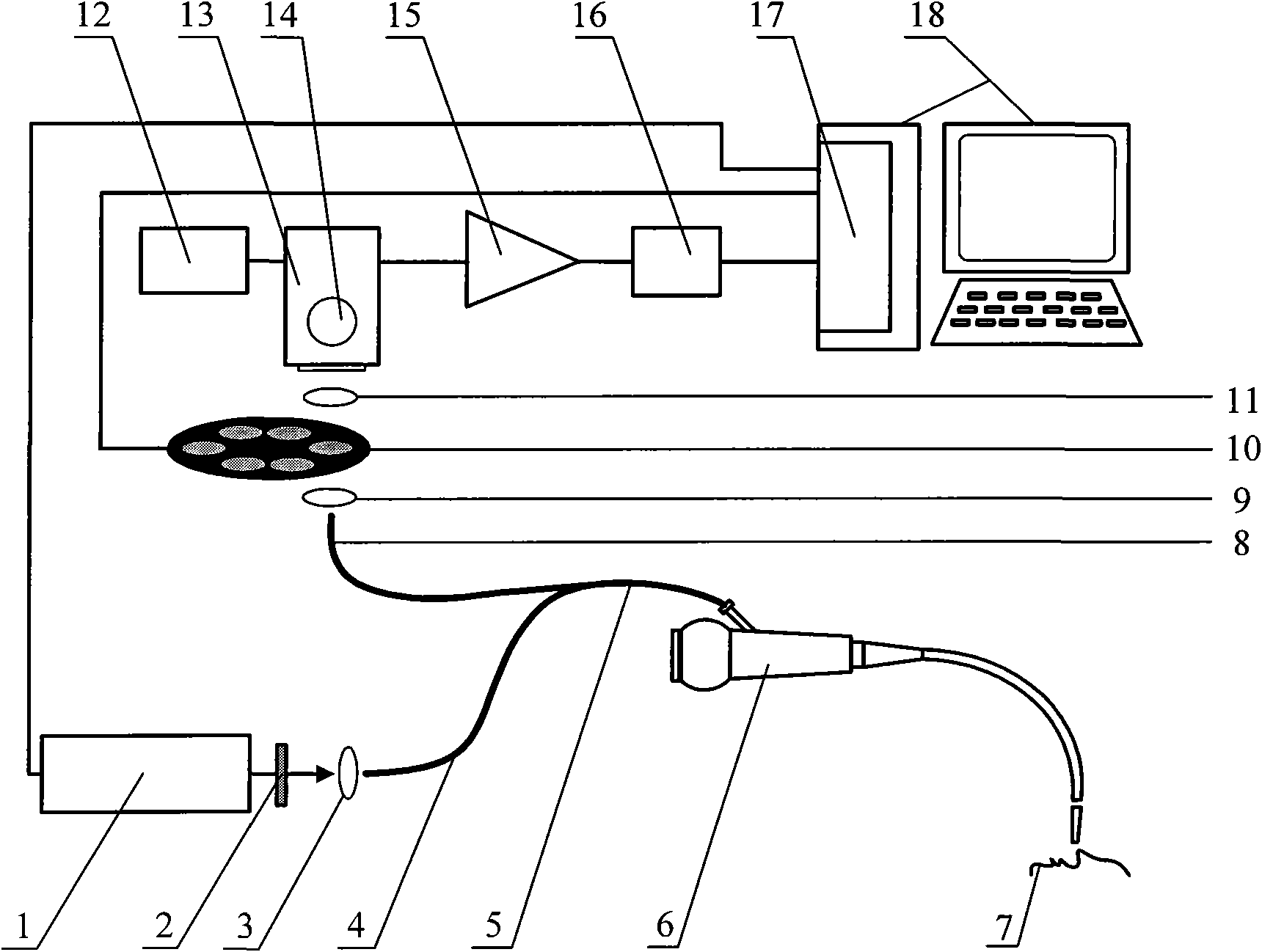Human tissue autofluorescence detection system based on excitation of light sources with different wavelength
A technology of human tissue and autofluorescence, applied in fluorescence/phosphorescence, material excitation analysis, etc., can solve the problems of ineffective excitation, information overlapping analysis, low sensitivity and specificity, etc., and achieve high sensitivity and specificity detection , Simplify the process of data processing, the best excitation and detection effect
- Summary
- Abstract
- Description
- Claims
- Application Information
AI Technical Summary
Problems solved by technology
Method used
Image
Examples
Embodiment 1
[0014] Such as figure 1 Shown is a diagram of the autofluorescence detection system based on excitation at different wavelengths. A case of human colon tissue was selected for the study of autofluorescence spectral characteristics. Before carrying out the experiment, the cooler (13) (C9144, Hamamatsu Corp., Japan) was opened and cooled for 30 minutes by the cooling voltage controller (12), so that the photomultiplier tube (14) (R928, Hamamatsu Corp., Hamamatsu, Japan) reached a stable working state. According to the experimental requirements, the computer (18) is turned on, and three thresholds I corresponding to the colon tissue have been stored in advance. T1 and I T2 , its numerical value is respectively 30000 and 3, turn on the tunable laser (1) (PIV OPO 355, OPOTEK, USA), adjust the output wavelength of the tunable laser (1) by the control software on the computer (18) to be 400nm, control simultaneously Select a filter with a center wavelength of 635 nm on the filter...
Embodiment 2
[0016] Another case of human colon tissue was selected for the study of autofluorescence spectral characteristics. According to the process of embodiment 1, at first select 400nm excitation light, detect the fluorescent signal I of 635nm 635 , the recorded value is 9000, which is less than the threshold I T1 , the tissue type could not be determined and further testing was required. Next, choose 280nm excitation light to excite, and detect the fluorescence signal I of 335nm 335 , whose value is 75000. Then choose 340nm excitation light, detect the fluorescent signal I of 390nm and 460nm 390 and I 460 , whose values are 70000 and 81000 respectively. Then choose 450nm excitation light to excite, and detect the fluorescence signal I at 535nm 535 , whose value is 10000. Finally, choose 460nm excitation light, detect the fluorescence signal I of 520 520 , whose value is 18000. Calculate I r =(I 460 +I 520 +I 535 )×I 335 / (I 390 ) 2 The result is 1.67, which is les...
Embodiment 3
[0018] Another case of human colon tissue was selected for the study of autofluorescence spectral characteristics. According to the process of embodiment 1, at first select 400nm excitation light, detect the fluorescent signal I of 635nm 635 , the recorded value is 60000, which is higher than the threshold I T1 , indicating that the porphyrin content is relatively high, and it is determined that the tissue to be tested is a colon tumor tissue.
PUM
 Login to View More
Login to View More Abstract
Description
Claims
Application Information
 Login to View More
Login to View More - R&D
- Intellectual Property
- Life Sciences
- Materials
- Tech Scout
- Unparalleled Data Quality
- Higher Quality Content
- 60% Fewer Hallucinations
Browse by: Latest US Patents, China's latest patents, Technical Efficacy Thesaurus, Application Domain, Technology Topic, Popular Technical Reports.
© 2025 PatSnap. All rights reserved.Legal|Privacy policy|Modern Slavery Act Transparency Statement|Sitemap|About US| Contact US: help@patsnap.com


